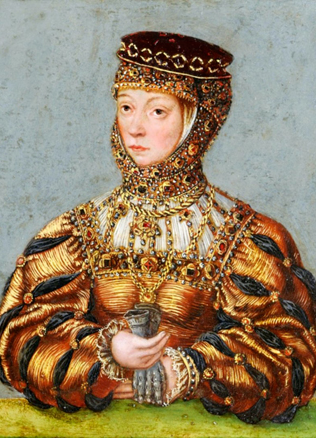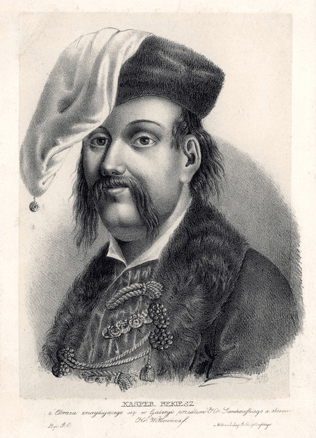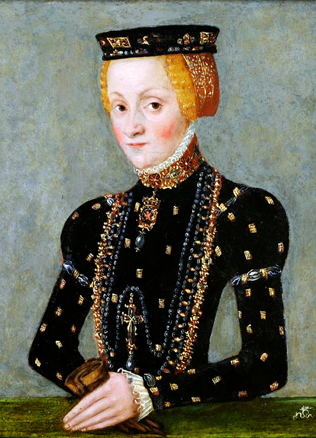Flag-bearers in the first half of the 16th century: unsuccessful district politicians
We do not know who the forty people flying the Lithuanian flags over the Tannenberg battlefield were. The signs that were on the flags described by the Polish Historian Jan Długosz – the Rider and the Pillars of Gediminids – allow us to suppose that Great Duke Vytautas distributed the flags among his regiments. Perhaps they were returned to the Ruler’s Treasury after the military campaign bet even in that case the people who carried the flags had to preserve the memory about the deed they once performed. Unfortunately, the legends about the origin of the Lithuanian noblemen who liked to boast about the real and imaginary achievements of their families, do not mention any flag-bearers of the times of Tannenberg.
Symbolic office of the preserver of the flag
Do You Know?
The reorganisation of the military and political structures gradually carried out in the Grand Duchy of Lithuania at the beginning of the 16th century “brought the flag bearers (Lat. vexillifer, Ruthenian хоружии) to new life again.” This does not mean that some new offices of flag-bearers were started to be created at that time. The majority of historians think that office of the flag-bearer existed throughout the entire 15th century, only flag-bearers of that time almost had no clearer military and social functions. The abundant sources of the first half of the 16th century testify to the fact that the tradition of flag-bearers had deep historical roots. At the beginning of the 16th century the flag-bearers of all districts were attached to the Rulers’ courts, which were often a castle in the 15th century. Even in those cases when the court was pledged to some nobleman, alongside the latter, a flag-bearer subordinate to him, is mentioned. It seems that flag-bearers were peculiar intermediaries between the district nobility and its elder to whom all the noblemen of the district were subordinate at that time.
We do not know what the flags of that period looked like. We can form their approximate picture from the description of the flags assigned to the districts during the time of the 1566 Reform. They were of different colours; however, a Rider (Vytis) was represented on the shield in the middle of all of them. This is another hint about the tradition that was cherished from the times of the Battle of Tannenberg.
Furthermore, until the middle of the 15th century, offices of flag-bearers of the districts most often were inherited, and the flags were kept in the houses of the flag-bearers.
For example, in 1527, Andrziej Moisiejewicz, a nobleman of Darsūniški, appealed to the Ruler asking the latter to give him offices of a local flag-bearer, which from the time of his great-grandfather who lived in the times of Vytautas, always belonged to their family. And the flag-bearers themselves most often came from the old noble families of the district. This is clearly seen in Samogitia where flag-bearers were descendants of the old Samogitian aristocrats: the Klausgailavičiai in Skirsnemunė and Raseiniai, the Rusteikavičiai in Veliuona (both families came from the supporters of Grand Duke Vytautas), and the family of the flag-bearers of Viešvėnai the Šondziai (Šandžiai?), according to Jonas Levickis, came from the pagan god Sidzius (Sidžius?). We see a similar view, only not so much adorned with the details of pre-Christian period of the history of Lithuania, in other districts of Lithuania: the Stirpeikos were flag-bearers in Upytė, the Dukes Giedraičiai were flag-bearers in Giedraičiai, and so on.
The families of flag-bearers were seldom well-off therefore at the beginning of the 16th century Lithuanian flag-bearers were sooner noble than rich. The flag-bearers who were regular witnesses to military services knew well the noblemen of the district, and the latter knew the flag-bearers. When the nobles had to choose their representative, most often a flag-bearer became one of them. On the other hand, the authority of the flag-bearers in the districts was well known to the ruling circles and in case of need they made use of that.
Flag-bearers’ fight against corruption
Do You Know?
The constantly renewing war with Moscow at the beginning of the 16th century made the Ruler of Lithuania supervise the system of military services of the nobility and taxes stricter. The nobility itself had to approve of the tax in silver taken from the estates of the nobility for military needs. Traditionally taking a tax in silver was approved by the meeting of the Council of Lords in the Sejm. Therefore, both declaring the new tax in silver and its actual collection depended on the nobility of Lithuania, which had wide and dense networks of estates and servants in the districts. This situation did not satisfy Great Duke Sigismund the Old who, when elected Ruler, encountered with large-scale embezzlement of the Ruler’s (the State’s) property carried out by the Lithuanian lords and abuse of their official position.
Expecting to reduce the influence of the nobility on the state, the Ruler’s court started gradually “to democratise” administration of military service. In 1511, the Ruler, when planning the session of the Sejm to be convened in Vilnius on 1 January of the following year, instructed the nobility of Lithuania to call gather the noblemen in the districts they governed and to elect two representatives to the Sejm from them. Though the documents do not state clearly, but it seems that those representatives had to take part in adopting the announcement of the new tax in silver. They did not have the right to vote in the Sejm. Their function was to receive all information about the tax (the time of collecting it, its size and the procedure for delivering it to the Treasury), and, upon return to their districts, to inform the local nobility thereof and, most probably, to take part in collecting the tax. It seems that the Ruler wanted to eliminate the lords from administrating the tax in silver who collected state taxes assisted by their servants.
The investigations show that the collectors of the tax in silver were often flag-bearers of the districts who had exact knowledge of the number of the nobles in the district, their financial situation and their family relations.
After the novelties of collecting taxes in silver justified themselves, the Ruler initiated the expansion of the functions of the representative of the nobility of the district. At the beginning of the 3rd decade of the 16th century the functions of military administration of the flag-bearers were clearly regulated. At that time already they were like those that were later legalised by the First Statute of Lithuania (1529): during conscription the flag-bearer had to call the nobility of the district; to bring the flag consisting of them to see the Elder; to provide the Elder with the information about who and for what reasons did not join the formation (the flag-bearer had the right to leave the sick nobles at home); to see to it that the flag of the district should not disperse, the horses of the nobles should be in the same herd, and that the noblemen should be armed the way they were armed during the inspection.
The tax collection and military activity of the flag-bearer provided for the fact that he did not only know nearly all the noblemen of the district but also that he had their lists (registers). Flag-bearers were assigned the function of controllers in the military service in the conscript army. Elders of the district, voivodes or hetmans of Lithuania controlled them.
Degradation of the “old customs”
When administrating the main duty of the nobility, flag-bearers acquired important duties in the time of peace too. Flag-bearers were counsellors of the court of the Elder, the most important (almost indispensable) witnesses of the noble origin to the proof cases, witnesses to the testaments of the nobility, etc. True, all these functions were attributed to the flag-bearers indirectly and were given to the individuals who fulfilled the duties of flag-bearers due to their personal authority.
It seems that the elders took advantage of this vagueness in the 3rd decade of the 16th century by pushing their servants to the offices of flag-bearers. Neither the nobility of the district nor the Ruler was happy about that.
Seeing that the office of the flag-bearer became a toy of the lords, the noblemen recruited flag-bearers to represent a district rarer and rarer.
Hence, the flag-bearers of the districts hardly retained their earlier authority in the middle of the 16th century. In 1564–1566, in carrying out the court and administration reform, the majority of the functions carried out unofficially by the flag-bearers were assigned to other officials. The duties of the flag-bearer were related to the military service even stricter.
Do You Know?
One can notice repercussions of the old position of flag-bearers even in the Second Statute of Lithuania (1566): “Office of the flag-bearers in all lands and districts of the Grand Duchy [of Lithuania} have to follow such procedures that We, the Ruler, should not appoint other flag-bearers except well-known, quick-witted, strong and firmly established ones in that district [who lived there for a long time and are well-off]. And the flag-bearer, when he has to carry a flag, must be in good armour and in a helmet and armed with [effective] weapons, and his horse must be good. And [the flag-bearer] must carry a flag himself in his squad during military inspection too, and in any other case. And he has to carry out this instruction properly as befits the flag-bearer: morally and honestly. According to the old custom, they have to be given the flags from Our [the Ruler’s] Treasury.”
Eugenijus Saviščevas



